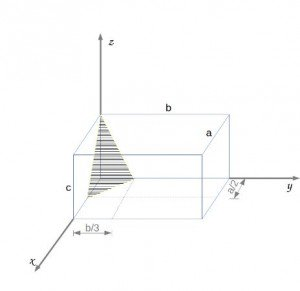This set of Materials Science Questions and Answers for Entrance exams focuses on “Crystallographic Directions and Planes”.
1. Which of the following is not true for crystallographic axes?
a) They must be parallel to the edges of the unit cell
b) They must be perpendicular to each other
c) They must originate at one of the vertices of the cell
d) They form a right-handed co-ordinate system
View answer
Explanation: The axes must be parallel to the edges of the unit cell, which in case of some crystal systems like monoclinic, hexagonal etc. are not mutually perpendicular.
2. The point coordinate indices q, r, and s are multiples of:
a) Unit cell edge lengths
b) Distance between nearest neighbours
c) Cosine of angles between unit cell edges
d) None of the mentioned
View answer
Explanation: Point coordinate indices are the fractions which when multiplied by the corresponding unit cell edge lengths, provide the location of a given point in the crystallographic coordinate system.
3. The point coordinates of the vertex just opposite to the origin are
a) 0 0 0
b) 0 0 1
c) 0 1 1
d) 1 1 1
View answer
Explanation: Since the opposite vertex is located at distances equal to the edge lengths along the coordinate axes.
4. If x, y, and z are three positive axes of the crystallographic coordinate system with origin at point A, then which line points in the direction [1 0 1] ?
![Find line points in the direction [1 0 1] if x, y, & z are three positive axes](https://www.sanfoundry.com/wp-content/uploads/2017/07/materials-science-questions-answers-entrance-exams-q4.png)
a) AD
b) CH
c) FB
d) GE
View answer
Explanation: Moving 1 unit along positive x-axis, 0 units along positive y-axis, 1 unit along negative z-axis points in a direction parallel to line FB.
5. In the following diagram, what is the direction cosine of the line EB?
![Find line points in the direction [1 0 1] if x, y, & z are three positive axes](https://www.sanfoundry.com/wp-content/uploads/2017/07/materials-science-questions-answers-entrance-exams-q4.png)
a) [1 11]
b) [111]
c) [1 1 1]
d) [1 0 0]
View answer
Explanation: One can reach from point E to B by traversing 1 unit along each of positive x, negative y, and negative z-axis, where one unit along any axis equals the corresponding edge length.
6. In cubic crystals, crystallographic directions are arranged in families. Which of the following directions does not belong to the family <110>?
a) [1 0 1]
b) [11 0]
c) [10 1̅]
d) None of the mentioned
View answer
Explanation: Since the cubic lattice is symmetrical about all the three axes, the above directions are equivalent irrespective of order & sign and are part of same direction family.
7. Convert [2 111] from four-index system to three-index system.
a) [2 1 0]
b) [3 0 1]
c) [111]
d) [12 1]
View answer
Explanation: [u v t w] can be converted to [U V W] using the formula: i) U = 2u+v ii) V = 2v+u iii) W = w. Four-index systems are generally used for hexagonal lattices.
8. Miller indices of the hatched plane in the following figure are:

a) (2 3 1)
b) (3 2 1)
c) (3 2 0)
d) (1 1 1)
View answer
Explanation: If a plane intercepts the coordinate axes at distances A, B, and C from the origin, then Miller indices are given by multiplying (a/A b/B c/C) by a suitable factor so as to obtain integers.
9. Which of the following is a property of Miller indices?
a) They uniquely identify a plane
b) They are always positive
c) They are not fractions
d) None of the mentioned
View answer
Explanation: Two or more planes can have same Miller indices which can be negative, zero or positive depending on the intercept on the axes. If the ratios of intercepts to lattice constants come out be fractional, then they are scaled to lowest integers to be represented as Miller indices.
10. Miller indices for perpendicular planes are always the same.
a) True
b) False
View answer
Explanation: It is true only for cubic lattices. For other systems, there is no simple relationship between planes with the same Miller indices.
Sanfoundry Global Education & Learning Series – Materials Science.
To practice all areas of Materials Science for Entrance exams, here is complete set of 1000+ Multiple Choice Questions and Answers.
If you find a mistake in question / option / answer, kindly take a screenshot and email to [email protected]
